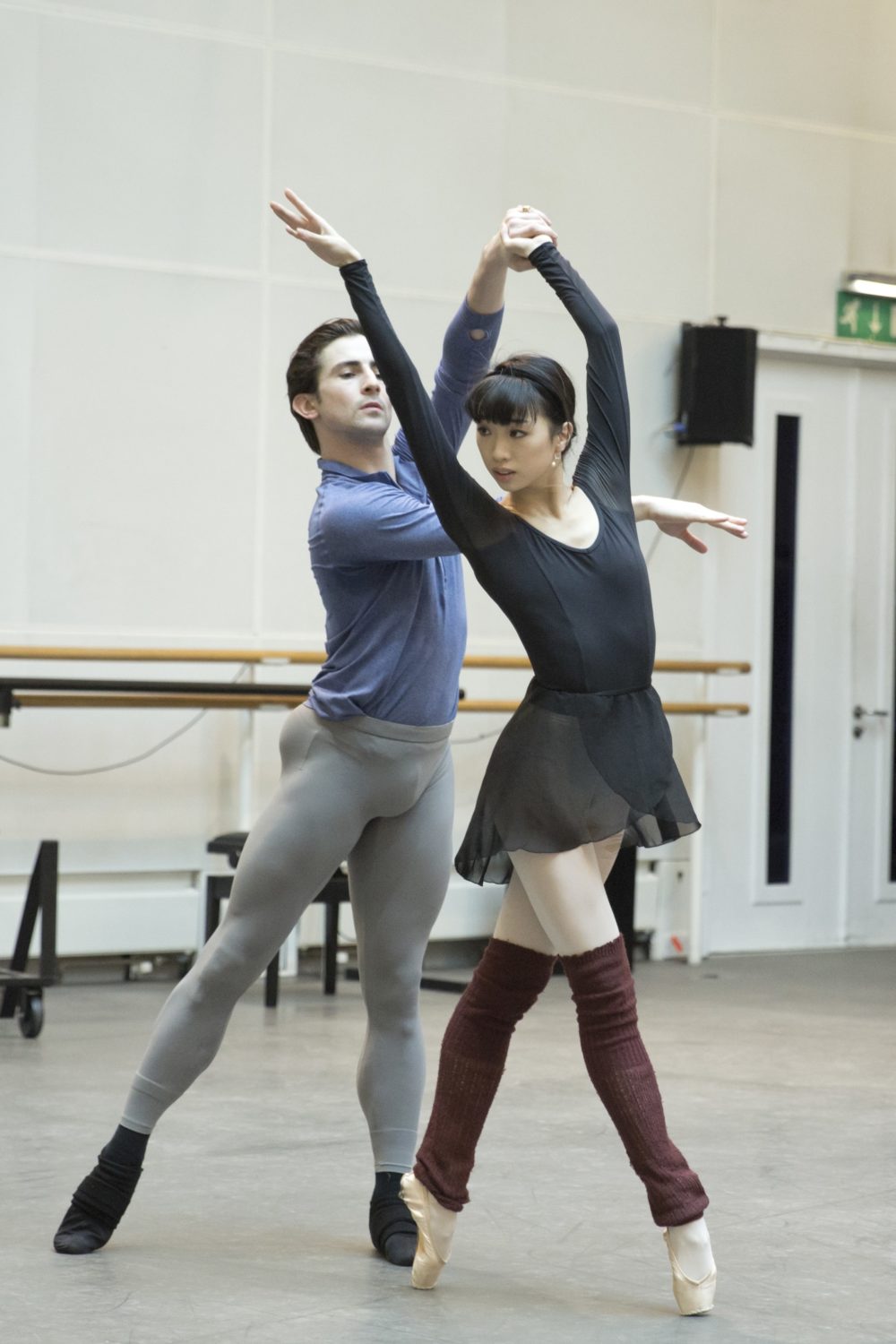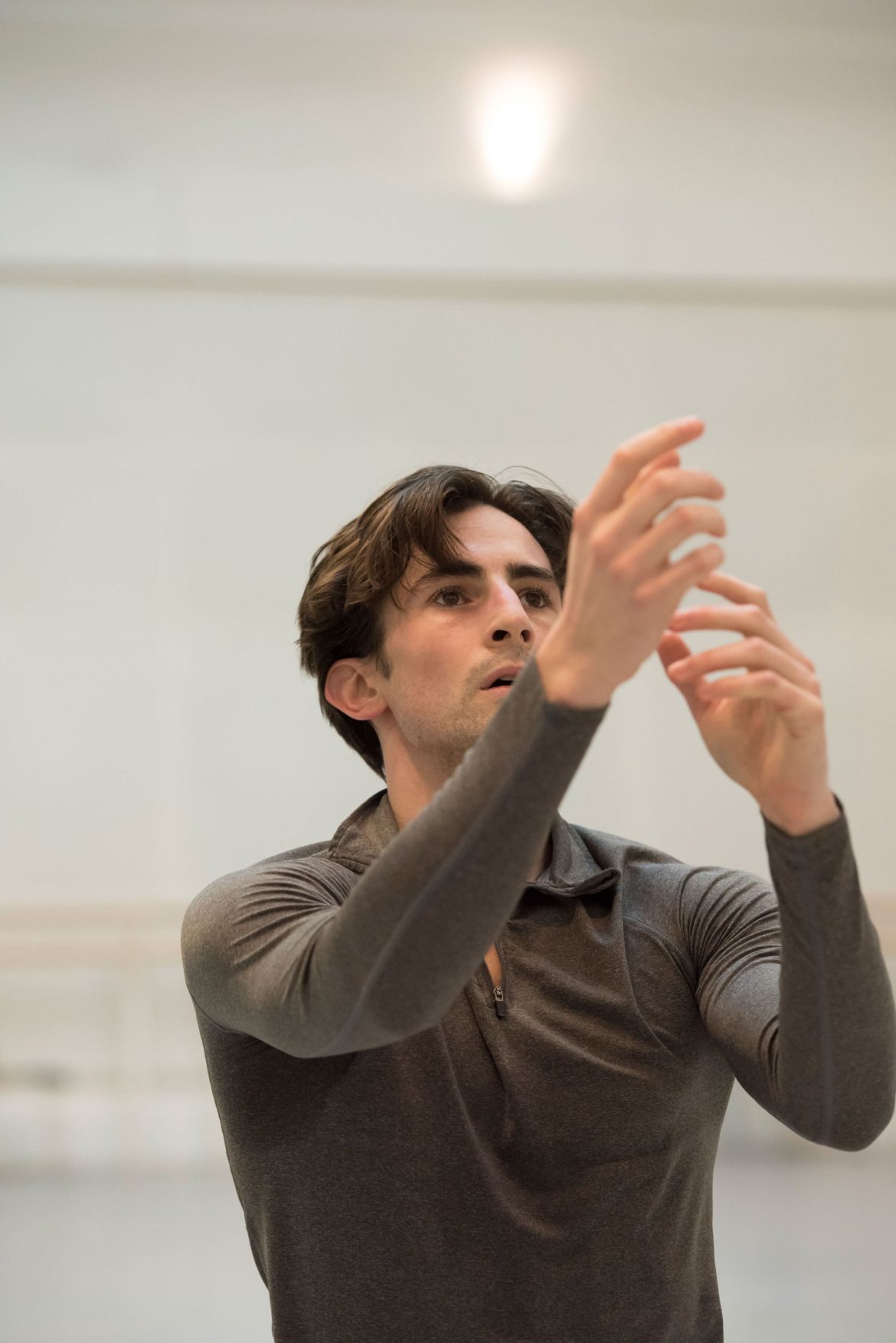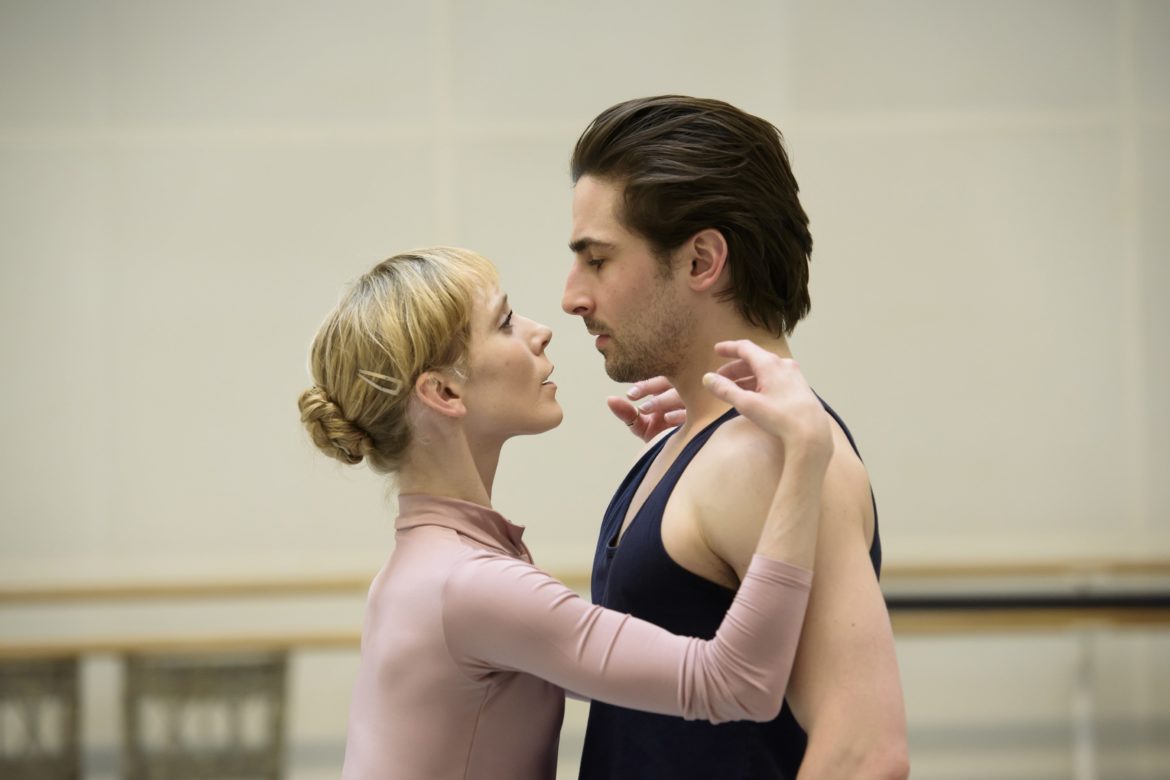American born Royal Ballet Soloist Tristan Dyer talks to us ahead of World Ballet Day (2 Oct), giving us an insight into life with the prestigious ballet company, his favourite roles, and how he prepares for the stage.
You can listen to our podcast with Tristan as he shares what he loves most about dancing, what inspired him to join The Royal Ballet and one of his favourite career moments of dancing with the gorgeous Sarah Lamb (pictured above – photo by Bill Cooper). You can read our interview below:

Hi Tristan, where are you at the moment?
At the Opera House – I have just been led to a little private room next to the Royal Box. For interviews, I get led to these places throughout the Opera House, which is kind of fun.
So you’re literally in the audience of the Royal Opera House?
Yes, it’s kind of weird when you cross over from backstage to front of House. There’s an instant change of interior. It’s great to come on this side of the stage too.
You’re looking back at the stage where you perform – it must be quite interesting to see in the Opera House….
I love coming up front because you really get a sense of how the audience feels. We really get wrapped up in our own world behind-the-scenes. It’s great to just come out front and experience that whole life and lifestyle that people come and enjoy when they come to see a show.
When and why did you start dancing?
I’m a classic case of a first-time dancer! My grandmother took me to a production of The Nutcracker. I was about four years old and after the show and I met some of the dancers. It was fun because they invited us up onto the stage. I think from that moment, just being up there and feeling that environment, it impacted me so much that from then on I begged my parents to take me to classes, which they were so supportive of. It’s something I have just continued and here I am.
That’s really amazing because the first contact that you were talking about with dance and dancers in a theatre setting is what World Ballet Day does; bringing people into the ballet world that you live and exist in every single day.
Exactly.
You trained at The National Ballet School of Canada, The Australian Ballet School, before heading over to The Royal Ballet School. Tell us about that experience of these three different places geographically, culturally?
I’m 27 now, so funny looking back! But certainly, you almost feel like it was a completely different life. We moved for my Dad’s work; he was in the corporate world at the time. I am originally American, from Newport, Rhode Island – which is where I started ballet classes.
We then relocated to Toronto, Canada. I was lucky enough to live in the city where there was the main ballet school, The National Ballet of Canada School. I was there for three years. I was involved in their production of The Nutcracker, which I think was my first real show with them as a kid. I was about 8 or 10 years old.
From there we relocated to Australia and also by chance, ended up the main city, Melbourne, where The Australian Ballet School is; it was very convenient and it was so easy and accessible for me, to keep up the training and stay on the journey I was on.
By the time I reached 16 – I think it’s very important you evaluate where you are and where you believe your future will be. Going to a vocational ballet school is important and by 16 you should probably aim for the company that you would like to be in eventually. For me that was The Royal Ballet. It’s always better to be in a feeder school to a company, so that you’re already involved in that atmosphere.
You could’ve gone to The Australian Ballet or The National Ballet of Canada, what was it about The Royal Ballet that made it the company that you really wanted to join?
I think first off, it’s really the history, it’s phenomenal! The ballets that were created here from Frederick Ashton to Kenneth MacMillan, they are timeless ballets and the classics that the Royal Ballet dances today. I think, being here knowing that this is part of history – this company has shaped so much of ballet history, that was definitely my first draw to the company.
When World Ballet Day takes place there will be loads of young male dancers who will be tuning in across the world watching yourself and other male company members taking the class, warming up, doing their rehearsals. Tell us, what is your typical day like at The Royal Ballet?
It’s amusing when I meet some people and they’ll ask me what my day job is – they think that I just come in to kick my shoes off and do a show in the evening! We are here from 10 in the morning, we’ll always do a regimented warm-up class – which is strictly to keep our technique in shape – and then we’ll be rehearsing all day.
We do about 12 different productions throughout the season – some of them being new works which require a lot of time with choreographers, others, being revivers. So you’ll maybe do some new roles. Rehearsals are from 12:00 until 6:30 and then maybe a show that evening.

You’ve been at The Royal Ballet almost 10 years, which will be a remarkable moment for your career. What are some of your favourite roles and why?
This actually links to what I was saying about the history – there’s a ballet called Symphonic Variations, that was created by Frederick Ashton. It’s really one of the most phenomenal ballets. We actually had just brought out a DVD of that ballet – it has six of us on stage, three boys, three girls. It really is something.
We’re on stage for the entire piece – about just under 20 minutes long – the music is so moving. Once the curtain goes up you feel that unity between the dancers and this incredible world. You’ve created this world you can escape into in this ballet which for me, although it’s not my most leading role, it’s really something that I hold close to my heart.
How do you prepare for the different types of roles? I think this is something which World Ballet Day might give viewers an insight into, but what’s your process?
For me, I love to run things through start to end, multiple times before the show. It’s very easy to work out tempos and how you want to do things, stop and start, but I think it’s so important for stamina. That’s my number one thing leading up to the show. Really push through even when things don’t work out in the studio. You’ve got to pretend that it is a show, to keep it up.
An hour or so before the curtain goes up, I think it’s really important to have your head in the game and you really have to then enjoy that moment. You hand it over to the stage. All the hard work – you just have to trust the work pays off and that’s where we find the enjoyment.
With World Ballet Day coming up you’ve got potentially millions of people tuning in, obviously you’re probably very comfortable at the Royal Opera House after almost 10 years, but do you still get nerves?
I do, but I would call it more of an excitement, adrenaline. I do have this sense, naturally, that it’s live theatre and it’s really why we’re doing this. I’ve learnt to not fret the small stuff. It’s never great to think of the negative before it happens. I calm the nerves by thinking, “This is the moment and enjoy it”. You have to go out there and try and not be nervous and channel that energy to the performance.
What do you love most about dancing?
I love the narrative works. Right now we’re about to open with Mayerling. I get to play a great role, his name is Bratfisch. He’s a close friend and chauffeur of Prince Rudolph and sees Prince Rudolph’s struggles. He knows what’s going on and he can see that he’s on the downward spiral.
I think getting involved in such an intense narrative is another incredible form of the art because it really is something as real as acting, I guess, and that’s such a great thing.
How do you physically move between the different types of movement that is required in the company’s wide repertoire?
The more modern works we tend to do is on an evening where it’s a triple bill, they’re three short bursts of half an hour, each their complete own entity. One may be extremely classical, with steps that you just have to execute impeccably – it’s the goal – then you’ll have an interval of 25 minutes and you’re in your next ballet doing something much more contemporary, with a different sort of fluid movement through the body.
It is that switch, and I think it does just happen naturally when you put your head into it – from one style to the next. I think we’re just so used to it that because we’re rehearsing so intensely, it just feeds in naturally.
On World Ballet Day you’re going to have cameras following the company throughout the day, tell us how you’re going to be involved.
Most of the company will be in our morning class, which is like I said, it’s that formulated techniques. We start at the barre; it’s more like a slow warm-up. Then we’ll move to the centre where we then progress exercises from adage of slow controlled movements to grande allegro, which is the large jumps, which is mainly where men do solos.
I’ll definitely be in the class. The schedule’s not been released for the rest of the day, but I think you’ll see certain rehearsals, about four or five different rehearsals of things that we’re working on. I believe that there’s a new work being created, so you’ll see live interaction with the choreographer too. I think it will be such a great day – always, every day.
It sounds like an amazing day, and particularly getting to watch new work being created. You’ve been involved in a number of creations yourself. Tell us about that experience. Is there something which you find as an artist invigorating or fulfilling, creatively?
It absolutely is. Talking about history, creating roles feels like you’re making your mark a little bit. I think having something created on you, it’s a gift. There aren’t too many different creations. I’ve been lucky enough to work with Liam Scarlett, Wayne McGregor and Christopher Wheeldon, who are our main choreographers that work with our company. It’s really something very special.
When you’re working with the choreographers and you’re creating these roles, what does that relationship in the studio feel like to you? You mentioned three of the biggest choreographers who all have a different approach. How does that feel for you?
It’s a great moment seeing how they interact with the dancers. They’ll see if something is working or not. You look at them and you can see their brain ticking over, “Do I like that or don’t I?” or “Does that person suit what I’ve just made for them?” It’s great to be involved just as much as they are, to make the movement as fulfilled as they would like it. It’s fantastic.
I think this will be one of the very popular moments for World Ballet Day, getting to see the choreographers and dancers working together. Do you think as the cameras follow you around it will feel like a performance throughout the day or will it just feel like another day for you as a dancer?
I think it will feel like another day, to be honest with you. We are broadening so much behind-the-scenes access every year. We do a lot of live cinema relay performances, which is very high-pressure. If you came backstage on one of those nights, I think you wouldn’t realise the extent of how big the evening is. But we just have to approach it like another show. It’s live and streamed all around the world, but it will feel like a normal day to us because we can’t focus on the cameras.
You mentioned the additional pressure of this live relay into cinemas. Where does that pressure come from? Is it from the number of people, because it’s live?
I think being live is a lot of pressure – anything that’s being recorded live. I think the number one thing you pray for is that you just don’t fall over. That’s the thing with live theatre – things happen. Millions of people watching one show in different cinemas around the world is probably the last thing you should focus on.
We love watching ballet in the cinema and some people actually love it more than being in the House or in a theatre, because they get to be so close to the dancers.
I agree, and I’d say more for the narrative works – we have another DVD coming out that portrays ballet so well on film because it’s a story that opens in a very intimate bar with four characters. Seeing the slight nuances in the interactions of the characters, seeing that close up on camera, you feel like it was more of a movie, and very involved. We of course try and carry our expressions as far as we can to the Opera House, but some ballets do really work out well on camera.
You’ve been with The Royal Ballet almost 10 years. Looking back, what have been some of your career highlights?
I made my debut in Frankenstein, which was created about two or three years ago. I think that being one of my first title roles of a full-length ballet, was incredible. But on top of that, the highlight for me was that I actually got to dance with Sarah Lamb, who was the dancer that I looked up to my entire life. I always tell her, “There’s a locker dedicated to you over at the school” because of her where we’d put pictures up of her. That was very surreal, and it was lovely because working with her was just a dream.

What are you looking forward to most on World Ballet Day?
I love the idea that so many people, younger people especially, can tune in. There’s not always that much footage put out there of behind the scenes. Certain dancers that some younger people look up to, you may not find as many videos as you would like to see.
I think it’s a wonderful thing they can see us live in our daily movement. Maybe that will keep them going and fulfil something in them for what they’re doing, keep their drive up for their career and pushing on further. I think it’s a fantastic thing to influence the younger generation.
What advice would you give to those younger dancers?
Growing up in this industry, I’m sure everyone’s seen different documentaries and the gruelling process we go through, which is a part of why we get there. But, they really have to do it for themselves. I think we get so caught up in what our teachers might think of us or whatnot.
My number one thing is having confidence from a young age, I think that gets you far. Stop caring what anybody thinks about you and keep your own self-confidence very high because that will drive you, I would say, to the top.
American born Royal Ballet Soloist Tristan Dyer talks to us ahead of World Ballet Day (2 Oct), giving us an insight into life with the prestigious ballet company, his favourite roles, and how he prepares for the stage.
Listen to Tristan talk about what he loves most about dancing, what inspired him to join The Royal Ballet and one of his favourite career moments of dancing with the gorgeous Sarah Lamb (pictured above – photo by Bill Cooper).
Tristan also shares his experiences of studying with The Royal Ballet School, The Australian Ballet School, The National Ballet of Canada School and shares his advice for aspiring dancers.
Follow Tristan on Instagram: @tristandyer
World Ballet Day
SAVE THE DATE: 2 October 2018
WATCH: The Royal Ballet’s live-stream broadcast via Facebook live
USE HASHTAG: #WorldBalletDay – to share your love


